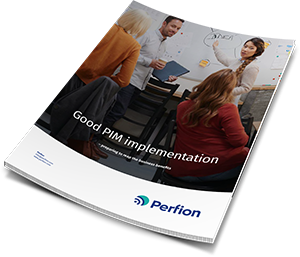
The reality is the same in one manufacturing or wholesale business after another: The volume of information about products, prices, product specifications and all sorts of other things is growing, and talented employees are struggling to keep track of the details of one spreadsheet after another. The processes are manual and the risk of errors is constant. At the same time, documentation is often under control, technically speaking, but lacking an overview.
This is part of why the global market for Product Information Management platforms (also called PIM systems) is enormous and is expected to grow at a compounded annual growth rate of 10.2% from now until 2024.
A PIM system can be just the tool to create an overview and help the company handle everything from small to enormous amounts of complex product information and distribute it effectively over the relevant channels.
Once you have decided to let a PIM system manage your product information, the first step is taken. Next comes the implementation phase.
|
Good PIM implementation |
PIM system implementation is a business project
In order for the PIM system to become a central part of the business infrastructure and contribute to the bottom line, it is imperative that the implementation phase be successful. It is in implementation that the foundation is laid, and this is also where one of the very core principles is established: PIM system implementation is not an IT project. It is a business project that must be rooted in management. In addition, input is needed from all the employees who have deep knowledge of the company's processes.
It makes sense to start with Marketing. Typically, employees in this department rely on the ability to quickly validate and edit product information in different systems. In addition, relevant personnel will often be product managers, warehouse managers, finance managers and of course people “on the floor”, such as accounting staff who are involved in the processes every single day and who depend on being able to navigate the systems efficiently. Getting the IT manager on board is also crucial because that person will be extremely important.
Prepare for a cultural change
There is a task of creating the right culture with regard to the PIM project as well. As with everything that breaks habits, the rule is: it is new and the new is often something “dangerous”. Be prepared to explain the benefits PIM will provide and be open to the inevitably resulting workflow changes. Nonetheless, these are changes that will generate benefits for people in every corner of the organization.
» Read a Perfion PIM user's recommendations to others facing a PIM project
The 7 classic do’s and don’ts
Basically, there is a long list of do’s and don’ts that are pretty much always relevant to consider when implementing a PIM system:
- Map data and create a complete overview of the necessary technical integrations (between ERP and PIM, for example).
- Establish a good culture between business and IT – everyone is on the same team and everyone has to pull in the same direction.
- Get management to take ownership of the project – strong management anchoring is a must.
- It is important to remember the most important factor of all: things take time. This also applies to PIM integration, so defuse the predictable frustration of making a realistic schedule.
- Valuable things cost money. So does a good PIM system, so look at the potential and view the project as an investment and not an expense.
- Keep the project as simple as possible. Do not build a rocketship when you can settle for a solid station wagon that can do the job, get good mileage and does not require expensive repairs.
- Go for a step-by-step implementation – start small and enhance the system over time. By all means, do not insist on developing an ironclad solution while constantly postponing the launch date. Use your energy in the preparation phase of data mapping, and then go with the simplest possible solution that adds value to the business so you start to reap both value and knowledge.
A PIM implementation may sound like an extensive task, but it basically just requires a structured process and a supplier who can provide input for all the necessary or desired phases of the process.
Download the ‘Good PIM implementation’ guide
 In this guide we will delve into such topics as putting together the right team, having the most constructive dialogue with the provider and the most frequent cultural challenges.
In this guide we will delve into such topics as putting together the right team, having the most constructive dialogue with the provider and the most frequent cultural challenges.
